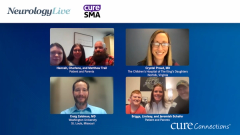
Specialist’s Evaluation of SMA in Children and Adolescents
Families describe their diagnostic journeys with SMA and when they were referred to SMA specialists.
Episodes in this series

Crystal Proud, MD: We’ve talked a little about this diagnostic journey that can delay diagnosis. Hannah, did you see other doctors before you found yourself in our neurology clinic? Or did your pediatrician send you straight to see us?
Hannah: We had been to a ton of doctors before we met you.
Crystal Proud, MD: Before you had the diagnosis, what specialists did you see?
Charlene: We just saw her pediatrician.
Matthew: When her pediatrician saw her that day, she stepped out of the room and called a neurologist. When she came back, she said she was going to send us over because she knew in her heart that that’s what it was. She’s the only person we saw.
Crystal Proud, MD: You have a very astute pediatrician and a great connection, at least in this community, between the pediatricians and the neurology team that was founded many years before I got here. That strong connection fostered that very quick referral pattern, which isn’t typical of our diagnoses of SMA [spinal muscular atrophy]. Do you agree, Dr Zaidman?
Craig Zaidman, MD: Absolutely. There’s a reason it’s so difficult for a primary care doctor to recognize spinal muscular atrophy: it’s rare, and developmental delay is common. Developmental delay usually isn’t spinal muscular atrophy. It’s usually something else.
The other reason it’s difficult is that spinal muscular atrophy isn’t just 1 disorder. It looks different in different people. Some children with the most severe form present in the first months of life and are very weak. They have trouble with breathing and feeding, and they can’t lift their arms or legs off the bed. Other children, like Hannah, present sometime around the age where people are expected to walk. Other children, like Briggs, can present in school-age years or even teenage years because they are slow running. That diversity of presentation makes it very challenging for a general practitioner to think of it and pick it up as early as they did with you, Hannah. It’s much more common to try a few things first before they end up in the hands of Dr Proud or myself.
Crystal Proud, MD: Briggs, do you know if you saw any other specialists before you were diagnosed?
Lindsay: Can I answer that?
Crystal Proud, MD: Absolutely.
Lindsay: We did. We had been with our pediatrician, our primary [care provider], a foot doctor, several chiropractors, Columbia, and Shriners [Children’s St. Louis]. The day he fell at school is when we saw the chiropractor who changed our lives. He knew something wasn’t right, but he didn’t know what was wrong. He had no problem saying, “I can’t fix this. I can’t tell you what’s wrong, but let me send you to a physical therapist in our hometown who I think can help.” I was leery at first, because we had been through so many of these situations where we’re told, “Let me send you here. Let me send you there.” The next day, she squeezed us in. Within the first 3 minutes, we went from flatfoot to the look on her face that I’ll never forget. You could tell. She asked, “Who’s your doctor?” I told her, and she said, “I’m going to call him quickly. I’m going to step out and give him a call. I think you probably need to see a neurologist.”
To go from flatfoot to neurologist, I had a hard time making [sense of it]. Where do we meet in the middle? What’s she talking about? The next day, they had scheduled him for an MRI. We weren’t home yet—it had been less than 15 minutes—and they said, “Your MRI looked great.” We were always being told, “It’s fine. This looks good.” The MRI came back, and they said, “We’re going to expedite you guys down to St. Louis to Dr Zaidman.”
Crystal Proud, MD: Some of those other tests that you’ve gone through that you’re describing are quite common when we’re evaluating patients in general neurology. Even in nerve and muscle specialty clinic, there can be tests that we ask you to go through before we confirm a diagnosis. Some can be longer tests, like MRIs, to make sure the structure of the brain and spinal cord are healthy—we want to make sure there isn’t a problem structurally with the signal getting from the brain down to the muscles. We may do some nerve and muscle testing with things like EMG [electromyography] or nerve conduction studies. But the ultimate test that we utilize to confirm a patient’s diagnosis of spinal muscular atrophy is what we call a molecular test, which is looking at your genetics, your DNA. There has been a lot of discussion about how we can make this journey shorter for families.
Transcript edited for clarity.
Newsletter
Keep your finger on the pulse of neurology—subscribe to NeurologyLive for expert interviews, new data, and breakthrough treatment updates.





















